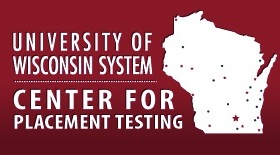Contents of the Mathematics Placement Test
Since 1978, UW system faculty and Wisconsin high school teachers have been collaborating to develop a test for placing incoming students into college Mathematics courses. The current test includes three sections: math fundamentals, advanced algebra, and trigonometry and analytic geometry. Each campus determines the appropriate scores for entry into specific courses. The purpose of this brochure is to introduce you to the test, describe the rationale behind its creation, and provide some sample test items.
Follow this Link for a Practice Mathematics Placement Test
Background and Purpose of the Test
In 1978, following the publication of the UW System Basic Skills Task Force Report, members of Mathematics Department Faculties from UW System institutions met in Madison to discuss common entry level curriculum problems. One problem most departments shared was how to effectively place incoming freshmen into an appropriate mathematics course. Placement procedures and tests varied from campus to campus and it seemed that some consistency was desirable. The decision was made to develop a System-wide test for placement into an introductory mathematics curriculum.
The committee that would begin this task would consist of representatives from any UW System Mathematics Department that chose to participate. After carefully analyzing each of the individual curricula in the System and writing and approving a detailed set of prerequisite objectives for all courses prior to calculus, the committee began developing test items on the skills identified in their test objectives. Through a series of pilot administrations at area high schools and UW campuses, the committee obtained valuable information about how the individual items performed. Many items were refined or corrected, as necessary, and repiloted in an effort to improve their ability to distinguish between students with different levels of mathematical preparedness. After a sufficient number of high quality items had been developed, they were assembled into a complete test. The first operational form of the Mathematics Placement Test was administered in 1984.
Since then, the math placement test has gone through various updates in order to keep with the content taught at the UW institutions. The ability of this test to appropriately place students into courses rests in the quality of the match between test content and the institutional curricula at each UW campus. To ensure that the test mirrors the curriculum in introductory mathematics courses throughout UW System, decisions on content, scores, and policy issues are made by the Mathematics Placement Test Development Committee which includes one representative from the 14 UW institutions, one Wisconsin high school mathematics teacher, and one representative from the Wisconsin Technical College System. This committee convenes twice each year to write and revise test items and discuss issues pertaining to test content and university curricula.
Placement into college courses is the sole purpose of this test. As a placement instrument, the test has to be easy enough to identify those students needing remedial help, yet it also has to be complex enough to identify those students who are ready for calculus. Scores have to be precise enough to allow placement into many different levels of university coursework. In addition, the test has to be efficient to score, since thousands of students each year need to have their results promptly reported. In order to meet these criteria, the test development committee selected a multiple choice format. The items measure three different areas of mathematical competence: math fundamentals (MFND), advanced algebra (AALG), and trigonometry and analytic geometry (TAG). Each skill area has a different set of detailed objectives, carefully developed to best match university mathematics curricula across the University of Wisconsin System. A combination of the three scores is used to place incoming students into the appropriate math course.
Every year, a new form of the Mathematics Placement Test is published, along with some new pilot items for each component of the test, and administered to all incoming freshmen in the UW System. All items are subjected to a statistical review to identify which items effectively distinguish the students with the strongest mathematics skills or the weakest mathematics skills from the general population of students. Only the items which are most useful for differentiating among students are ever considered for use on a future form of the test.
Although faculty cannot be considered disinterested observers, those who are familiar with the placement test feel that its quality is extremely high. The feeling among faculty at the participating UW institutions is that the test has helped enormously in placing students into appropriate courses. One of the strengths of the Mathematics Placement Test is that it is developed by faculty from throughout the University of Wisconsin System. Therefore, this test represents a UW System perspective with respect to the underlying skills that are necessary for success in our courses.
Recent Developments
In October 2013, the UW System formed the UW System-wide Remedial Education Work Group which was charged with reviewing policies, data related to, and existing programs aimed at remedial education (herein referred to as developmental education) within UW System. One of the resulting decisions based on the work of the Work Group was a move to standardize placement into/out of developmental mathematics across UW System. One challenge in doing so is that the UW System institutions do not have a single Mathematics curriculum. Instead, each campus has its own curriculum and its own courses, which may or may not correspond well with courses on other UW campuses. This is true for developmental level mathematics as well. Thus, the first step in standardizing placement out of a developmental math course was to define the UW System’s expectations of what an incoming student should know and be able to do in mathematics. The UW System Vice President charged the UW Center for Placement Testing and the Mathematics Placement Test committee with this task.
A subgroup of the math placement test committee convened to begin to work on determining the knowledge, skills, and abilities (KSAs) that students are expected to possess in order to enter into a credit-bearing math course at any UW System campus. The KSAs were developed by assessing both the curricula on the UW campuses and the Wisconsin Standards for Mathematics. After multiple revisions and responding to feedback from various stakeholders, the full math placement test committee voted unanimously during their spring 2015 meeting to accept the list of KSAs as criteria for placement into credit-bearing mathematics. These criteria became the content objectives for the math fundamentals section of the test (see Table 1).
Prior to 2017, the scores reported on the math placement test were basic math skills, algebra, and trigonometry. When deriving the list of expectations it was found that there would be a resulting shift in content on the math placement test. Specifically, some content that was previously measured on the algebra component of the test was identified as necessary knowledge for placement into credit-bearing mathematics, therefore this content shifted onto the new math fundamentals scale. The current math fundamentals scale measures the criteria for placement into credit-bearing mathematics and is largely comprised of objectives from the former basic math skills scale, as well as some content objectives from the former algebra scale. As such, the algebra scale has now become an advanced algebra scale. The trigonometry section remains the same in terms of content and blueprint; however we have chosen to rename the section to Trigonometry and Analytic Geometry.
With the 2017 changes to the math placement test, it was also decided that all UW campuses will now use a common cutscore on math fundamentals to determine placement into/out of developmental mathematics. As all UW campuses will now be using the same expectations for placement out of developmental education, a common cutscore must be imposed in order ensure that a student who meets the expectations, based on their score on their math fundamentals score, will place into credit-bearing math regardless of the campus they choose to attend. The next step was to translate the list of knowledge, skills, and abilities expected of incoming freshmen into a cutscore on the math fundamentals scale of the placement test. This was done through a process known as standard setting.
Simply put, standard setting is the process by which a cutscore is established. Cizek (1993) further defined standard setting as “the proper following of a prescribed, rational system of rules or procedures resulting in the assignment of a number to differentiate between two or more states or degrees of performance” (p. 100). The purpose of the standard setting meetings was to determine the cutscore on the math placement test math fundamentals (MFND) scale which a student must meet in order to test out of developmental level math courses. The intent was to select the cutscore which minimizes the chances of placing students out of developmental level math who do not possess the necessary level of math ability (false-positives) or students placing students into developmental level math who had adequate pre-requisite knowledge (false-negatives).
After conducting two separate standard setting panels with representatives from all UW institutions, some Wisconsin high schools, and the Wisconsin Technical College System, it was determined that a student must obtain a score of 470 or higher on the math fundamentals section of the placement test in order to place into credit-bearing mathematics. However, individual campuses are free to determine multiple pathways and/or additional supports for students scoring below 470 on the math fundamentals section.
In addition, each UW institution determines its own cutscores for placement above the developmental level so as to optimize placement into its own Mathematics course sequence. Consequently, cutscores above 470 on math fundamentals and cutscores on the advanced algebra and trigonometry and analytic geometry sections will vary from campus to campus as a result of curricular differences and student population differences. Also, on many campuses, the placement test is but one of several variables used for placing students, often also including ACT/SAT score, units of high school mathematics, and grades in high school mathematics courses.
General Characteristics of the Test
- All items are to be completed by all students. The items are roughly ordered from elementary to advanced. The expectation is that less prepared students will answer fewer questions correctly than more prepared students.
- The test consists entirely of multiple choice questions, each with five choices.
- The test is scored as the number of correct answers, with no penalty for guessing. Each item has only one acceptable answer. This number correct score is converted to a standard score between 150 and 850 for the purposes of score reporting.
- The Mathematics Placement Test is designed as a test of skill and not speed. Ample time is allowed for most students to answer all questions. Ninety (90) minutes are allowed to complete the test.
- The math fundamentals component has a reliability of .89. The advanced algebra component has a reliability of .88. The trigonometry and analytic geometry component has a reliability of .85. For all three sections, items are selected of appropriate difficulty to provide useful information within the range of scores used for placement throughout the System campuses.
Test Description
The Mathematics Test Development Committee decided on three broad categories of items: math fundamentals, advanced algebra, and trigonometry. The entire Mathematics Placement Test is designed to be completed in 90 minutes, sufficient time for most students to complete the test.
Items for each of the three components are selected to conform to a carefully created set of detailed objectives. The percentage of items selected from each component are shown in Table 1 below.
Table 1
Math Fundamentals Score
Objectives |
Percentage of Scale |
|
|
ARITHMETIC |
|
|
1. Integer Arithmetic 2. Rational and Decimal Arithmetic 3. Introducing Algebraic Skills |
5.0 |
|
|
|
ALGEBRA |
|
|
1. Simplifying Algebraic Expressions
2. Factoring Algebraic Expressions 3. Linear and Quadratic Equations 4. Linear Equalities 5. Introduction to Solving Rational and Radical Equations 6. Functions 7. Solving Literal Equations |
10.0 |
|
|
GEOMETRY |
|
|
1. Plane Geometry 2. Three-Dimensional Geometry 3. Geometric Relationships | 10.0 |
|
Advanced Algebra Score
Objectives |
Percentage of Scale |
|
|
ALGEBRA |
|
|
1. Graphs of Non-Linear Equations 2. Simplifying Expressions 3. Quadratics |
3.0 |
|
|
GEOMETRY |
|
|
1. Geometric Relationships 2. Circles and Other Conics |
3.0 |
|
|
ADVANCED ALGEBRA |
|
|
1. Radicals and Fractional Exponents 2. Absolute Value and Inequalities 3. Functions 4. Exponentials and Logarithms 5. Complex Numbers and Theory of Equations 6. Applications |
8.0 |
Trigonometry and Analytic Geometry Score
Objectives |
Percentage of Scale |
|
|
TRIGONOMETRY |
|
|
1. Basic Trigonometry Definitions 2. Identities 3. Triangles 4. Graphs |
30.0 |
|
|
GEOMETRY |
|
|
1. Circles 2. Triangles 3. Parallel/Perpendicular Lines |
15.0 |
Note: The following sample items are scanned images and as such, do not have the clarity that the items have when printed in test booklets.
Sample Items from the Math Fundamentals Component
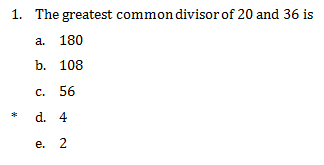
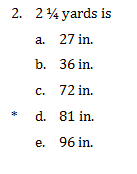
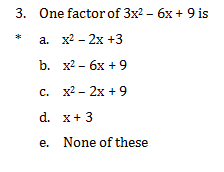
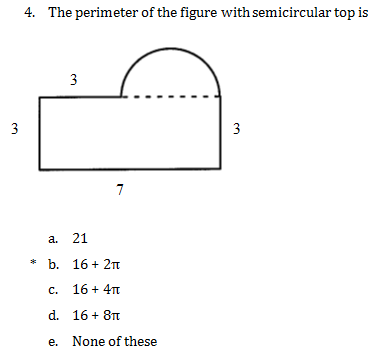
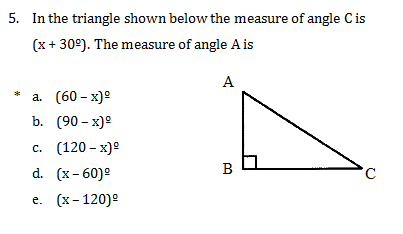
Sample Items from the Advanced Algebra Component
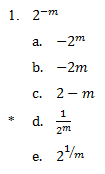
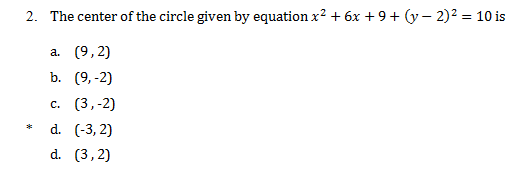
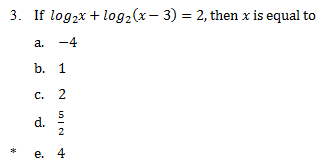
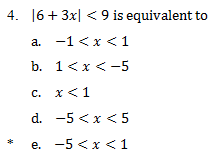

Sample Items from the Trigonometry and Analytic Geometry Component
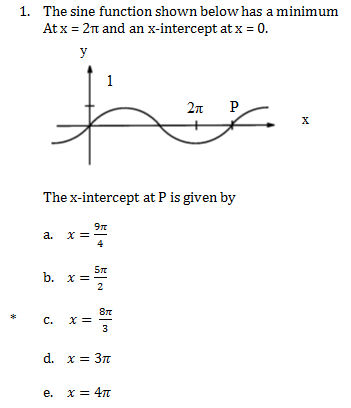
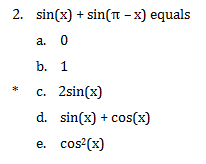



Additional Statements About High School Preparation for College Mathematics Study
CALCULUS
The number of high schools offering some version of calculus has increased markedly since the UW System Math Test Committee's first statement of objectives and philosophy, and experience with these courses has shown the validity of the Committee's original position. This position was that a high school calculus program may work either to the advantage or to the disadvantage of students depending on the nature of the students and the program. Today, it seems necessary to mention the negative possibilities first.
A high school calculus program not designed to generate college calculus credit is likely to
mathematically disadvantage students who go on to college. This is true for all such students whose college program entails use of mathematics skills, and particularly true of students whose college program involves calculus. High school programs of this type tend to be associated with curtailed or superficial preparation at the precalculus level and their students tend to have algebra deficiencies which hamper them not only in mathematics courses but in other courses in which mathematics is used.
The positive side is that a well-conceived high school calculus course which generates college
calculus credit for its successful students will provide a mathematical advantage to students who go on to college. A study by the Mathematical Association of America identified the following features of successful high school calculus programs:
- they are open only to interested students who have completed the standard four year college preparatory sequence. A choice of mathematics options is available to students who have completed this sequence at the start of their senior year.
- they are full year courses taught at the college level in terms of text, syllabus, depth and rigor
- their instructors have had good mathematical preparation (e.g. at least one semester of
junior/senior level real analysis) and are provided with additional preparation time.
- instructors expect that their successful graduates will not repeat the course in college, but will get college credit for it.
A variety of special arrangements exist whereby successful graduates of a high school calculus course may obtain credit at one or another college. A generally accepted method is for the students to take the Advanced Placement Examinations of the College Board. Success rates of students on this exam can be a good tool for evaluation of the success of a high school calculus course.
GEOMETRY
The range of objectives in this document represents a small portion of the objectives of the traditional high school geometry course. The algebra objectives represent a substantial portion of the objectives of traditional high school algebra courses. The imbalance of test objectives can be explained in part by the nature of the entry level mathematics courses available at most colleges. The first college mathematics course generally will be either calculus or some level of algebra. A choice is usually based on three factors: (1) high school background; (2) placement test results; (3) curricular objectives. One reason for the emphasis on algebra in this document and on the test is that virtually all college placement decisions involve placement into a course which is more algebraic than geometric in character.
Still, there are reasons for maintaining a geometry course as an essential component in a college preparatory program. Since there are no entry level courses in geometry at the college level, it is essential that students master geometry objectives while in high school. High school geometry contributes to a level of mathematical maturity which is important for success in college.
LOGIC
Students should have the ability to use logic within a mathematical context, rather than the ability to do symbolic logic. The elements of logic which are particularly important include:
- Use of the connectives “and’ and “or” plus the “negation” of resultant statements, and recognition of the attendant relationship with the set operations “intersection,” “union,” and “complementation.”
- Interpretation of conditional statements of the form “if P then Q,” including the recognition of converse and contrapositive.
- Recognition that a general statement cannot be established by checking specific instances (unless the domain is finite), but that a general statement can be disproved by finding a single counter example. This should not discourage students from trying specific instances of a general statement to conjecture about its truth value.
Moreover, logical thinking or logical reasoning as a method should permeate the entire curriculum. In this sense, logic cannot be restricted to a single topic or emphasized only in proof-based courses. Logical reasoning should be explicitly taught and practiced in the context of all topics. From this, students should learn that forgotten formulas can be recovered by reasoning from basic principles, and that unfamiliar or complex problems can be solved in a similar way.
Although only two of the objectives explicitly refer to logic, the importance of logical thinking as a curriculum goal is not diminished. This goal, as well as other broad-based goals, is to be pursued despite the fact that it is not readily measured on placement tests.
PROBLEM SOLVING
Problem solving involves the definition and analysis of a problem together with the selecting and combining of mathematical ideas leading to a solution. Ideally, a complete set of problem solving skills would appear in the list of objectives. The fact that only a few problem solving objectives appear in the list does not diminish the importance of problem solving in the high school curriculum. The limitations of the multiple choice format preclude the testing of higher level problem solving skills.
MATHEMATICS ACROSS THE CURRICULUM
Mathematics is a basic skill of equal importance with reading, writing, and speaking. If basic skills are to be considered important and mastered by students, they must be encouraged and reinforced throughout the curriculum. Support for mathematics in other subject areas should include:
– a positive attitude toward mathematics
– attention to correct reasoning and the principles of logic
– use of quantitative skills
– application of mathematics curriculum.
COMPUTERS IN THE CURRICULUM
The impact of the computer on daily life is apparent, and consequently many high schools have instituted courses dealing with computer skills. While the learning of computer skills is important, computer courses should not be construed as replacements for mathematics courses.
CALCULATORS
There are occasions in college math courses when calculators are useful or even necessary (for example, to find values of trig functions), so students should be able to use calculators at a level consistent with the level at which they are studying mathematics (four-function calculators initially, scientific calculators in pre-calculus). A more compelling reason for being able to use calculators is that they will be needed in other courses involving applications of mathematics. The appropriate use of a calculator is very definitely a part of college preparation.
On the other hand, students need to be able to rapidly supply from their heads – whether by calculation or from memory – basic arithmetic, in order to be able to follow mathematical explanations. They should also know the conventional priority of arithmetic operations and be able to deal with grouping symbols in their heads. For example, students should know that (-3)2 is 9, that -32 is -9, and that (-3)3 is -27 without needing to push buttons on their calculators. Moreover, students should be able to do enough mental estimation to check whether the results obtained via calculator are approximately correct.
Beginning in the spring of 1991, the use of scientific calculators has been allowed on the UW Mathematics Placement Test. The test was redesigned to accommodate the use of scientific calculators, so as to minimize the effects on placement due to the use or nonuse of calculators. Exact numbers such as √2 , √5 , and π continue to appear in both questions and answers where appropriate.
Use of scientific, non-graphing calculators is optional. Each student is advised to use or not use a calculator in a manner consistent with his or her prior classroom experience. Calculators will not be supplied at the test sites.
Mathematics curricula and faculty throughout UW are divided on whether or not to permit graphing calculators in classrooms. There remain many college-level courses for which graphing calculators are not allowed. Therefore, the placement test has not been revised to accommodate the use of graphing calculators. Students may not use graphing calculators for the Mathematics Placement Test.
PROBABILITY AND STATISTICS
Although university curricula are somewhat in a state of flux, with many basic issues and philosophies being examined, the normal entry level courses in mathematics remain the traditional algebra and calculus courses. Therefore, the placement tests must reflect those skills which are necessary for success in these courses. This is not intended to imply that courses stressing topics other than algebra and geometry are not vital to the high school mathematics curriculum, but rather that those topics do not assist in placing students in the traditional university entry level courses.
Probability and statistics are topics of value in the mathematical training of young people today that are not reflected on the placement test. It is the Committee's feeling that these topics are important to the elementary and secondary curriculum. They are gaining significance on university campuses, both within mathematics departments and within those departments not normally thought of as being quantitative in nature. The social sciences are seeking mathematical models to apply, and in general these models tend to be probabilistic or statistical. As a result, the curriculum in these areas is becoming heavily permeated with probability and statistics.
Mathematics departments are finding many of their graduates going into jobs utilizing computer science or statistics. Consequently, their curricula are beginning to reflect these trends. The
Committee urges the educational community to develop and maintain meaningful instruction in probability and statistics.
How Teachers Can Help Students Prepare for the Test
The best way to prepare students for the placement tests is to offer a solid mathematics curriculum and to encourage students to take four years of college preparatory mathematics. We do not advise any special test preparation, as we have found that students who are prepared specifically for this test, either by practice sessions or the use of supplementary materials, score artificially high. Often such students are placed into a higher level course than their background dictates, resulting in these students either failing or being forced to drop the course. Due to enrollment difficulties on many campuses, students are unable to transfer into a more appropriate course after the semester has begun. We do, however, provide a full-length practice exam on our website so that students can familiarize themselves with the types of items they will see on the actual placement test.
Significant factors in the placement level of a student are the high school courses taken as well as whether or not mathematics was taken in the senior year. Data indicate that four years of college preparatory mathematics in high school not only raises the entry level mathematics course, but predicts success in other areas as well, including the ability to graduate from college in four years. On average, students who have taken four years of mathematics in high school score significantly higher on all three portions of the math placement test than students who have not completed four years of high school mathematics. Teachers should certainly feel free to encourage students to be well-rested and try to remain as relaxed as possible during the test. We intend that the experience be an enjoyable, yet challenging one. Remember that the test is designed to measure students at many different levels of mathematical preparedness; all students are not expected to answer all items correctly. There is no penalty for guessing, and intelligent guessing will most likely help students achieve a higher score.
Use of the Tests
When the UW System Mathematics Placement Tests were developed, they were written to be used strictly as a tool to aid in the most appropriate placement of students. They were not designed to compare students, to evaluate high schools or to dictate curriculum. The way an institution chooses to use the test to place students is a decision made by each institution. The Center for Placement Testing can and does help institutions with these decisions.
Each campus will continue to analyze and modify its curriculum and hence will continue to modify the way in which it uses the placement tests to place students. Cutoff scores might need to be changed over time to reflect the prerequisites for a campus’ curriculum. It is also important for follow-up studies to be made to determine the effectiveness of the placement procedures. Contact must be maintained with the high schools so that modifications in the curriculum in both the high schools and in the UW System can be discussed.
Future Directions of the Test
As the mathematics curriculum continues to evolve, the UW System Mathematics Placement Tests will evolve with it. Since the members of the UW System Mathematics Placement Test Committee are faculty who regularly teach the entry level courses, they have a direct impact on the evolution of these courses, and the creation of new courses. In this way the UW System Mathematics Placement Tests can change immediately with the curriculum where national tests will have a lag-time of up to several years. An indication of this is the use of calculators on the UW System Mathematics Placement Tests in 1991. Prior to 1991, calculators were not allowed on this test. However, there was sufficient interest in the use of calculators by both high school and college teachers that the tests were modified to allow calculator use if a student wished.
The content of this test will be reviewed continually and analyzed to be sure that it is current and meaningfully related to the curricula in the introductory Mathematics courses around the UW System. We will also be continually adding new questions to a growing bank of questions now being written. Data on how each question functions under actual testing conditions has been and will continue to be used to replace items that are no longer functioning well.
Return to Homepage
